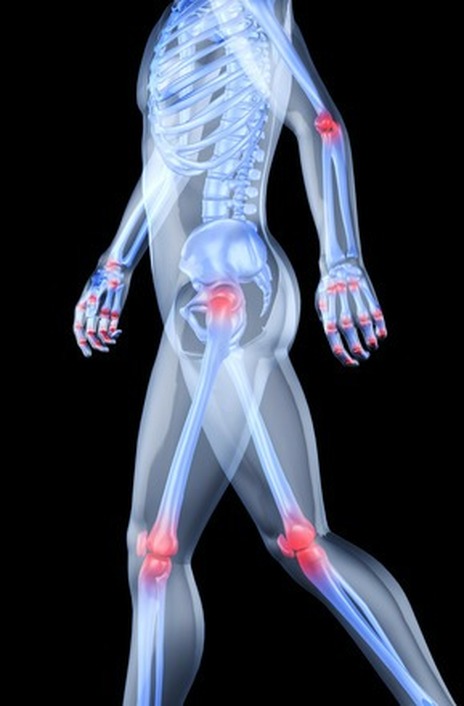
Cartilage - The cushion for your joints
Cartilage covers the ends of bones to prevent them from rubbing painfully against each other and to absorb shock as they move. It requires glucosamine, which the body produces from glutamine (found in glutamine-rich plant foods) and glucose.
That's not all. The human body needs glucosamine to produce chemicals involved in building not only cartilage, but tendons, ligaments, synovial fulid (the thick fluid that surrounds joints), nails, skin, eyes and heart valves. Glucosamine helps cartilage absorb water and keeps joints lubricated. It plays a role in the mucous secretion of digestive, respiratory and urinary tracts. Glucosamine, a naturally occurring compound in the body, is important for the healthy growth of bones and joints in children so that they can grow tall.
People of all ages, from growing children to the elderly, need glucosamine for healhty joints. As the body ages, it needs more antioxidants to help maintain healthy cell regeneration. A plant-based diet rich in glutamine and antioxidants provides the body with material to stimulate glucosamine production and help prevent osteoarthritis.
Glucosamine is an amino sugar produced naturally by the body from glucose (a sugar) and glutamine (an amino acid).
Glucosamine is needed to produce glycosaminoglycans, which are major components of cartilage.
Wholesome plant foods present nutrients in natural, balanced and safe combinations.
The right wholesome plant foods can stimulate the body to secrete glucosamine and chondroitin sulfate to protect joints, especially when the body needs them.
Athough the elderly cannot secrete enough glucosamine, antixodants from plant foods can speed up its production.
Each plant food is a unique and balanced package of antioxidants, phytochemicals and polysaccharides to nourish the immune system and cartilage.
The human body may need more glutamine than usual in cases of heavy exercise, infection, surgery, and trauma such as burn injury. That is why it is important to nourish the body with a plant-based diet that is rich in glutamine.
Good plant sources of glutamine include brown algae, parsley and spinach. Note that cooking destroys glutamine in vegetables.
Brown algae
Parsley
Spinach
Plant rich in antioxidants
Acerola Cherries
Plants with anti-inflammatory properties
Ginger
Alfalfa
Cactus
Cartilage covers the ends of bones to prevent them from rubbing painfully against each other and to absorb shock as they move. It requires glucosamine, which the body produces from glutamine (found in glutamine-rich plant foods) and glucose.
That's not all. The human body needs glucosamine to produce chemicals involved in building not only cartilage, but tendons, ligaments, synovial fulid (the thick fluid that surrounds joints), nails, skin, eyes and heart valves. Glucosamine helps cartilage absorb water and keeps joints lubricated. It plays a role in the mucous secretion of digestive, respiratory and urinary tracts. Glucosamine, a naturally occurring compound in the body, is important for the healthy growth of bones and joints in children so that they can grow tall.
People of all ages, from growing children to the elderly, need glucosamine for healhty joints. As the body ages, it needs more antioxidants to help maintain healthy cell regeneration. A plant-based diet rich in glutamine and antioxidants provides the body with material to stimulate glucosamine production and help prevent osteoarthritis.
Glucosamine is an amino sugar produced naturally by the body from glucose (a sugar) and glutamine (an amino acid).
Glucosamine is needed to produce glycosaminoglycans, which are major components of cartilage.
Wholesome plant foods present nutrients in natural, balanced and safe combinations.
The right wholesome plant foods can stimulate the body to secrete glucosamine and chondroitin sulfate to protect joints, especially when the body needs them.
Athough the elderly cannot secrete enough glucosamine, antixodants from plant foods can speed up its production.
Each plant food is a unique and balanced package of antioxidants, phytochemicals and polysaccharides to nourish the immune system and cartilage.
The human body may need more glutamine than usual in cases of heavy exercise, infection, surgery, and trauma such as burn injury. That is why it is important to nourish the body with a plant-based diet that is rich in glutamine.
Good plant sources of glutamine include brown algae, parsley and spinach. Note that cooking destroys glutamine in vegetables.
Brown algae
- Rich in chlorophyll for tissue repair
- Rich in phytoestrogens (e.g. isoflavonoids and lignans) for bone protection
- Fucoxanthin, which gives brown algae their color, can promote bone health
Parsley
- High in glutamine and vitamin C
- A 100-gram serving provides 2,050% of vitamin K needed daily by an adult for strong bones
- Helpful for arthritis and rheumatism in removing uric acid wastes from tissues
Spinach
- High in glutamine
- Supports bone health with chlorophyll, magnesium, manganese, calcium and vitamin C
- Antioxidant and anti-inflammatory properties
Plant rich in antioxidants
Acerola Cherries
- Originating in tropical America, acerola cherries are naturally rich in vitamin C, a powerful antioxidant. High amounts of vitamin C aid vitamin B12 and iron absorption. Acerola cherries contain 33 times or over 3,000% the amount of vitamin C in orange juice, making them perfect complement to vitamin B12 and iron. It also helps to protect joints against rheumatoid arthritis.
- It has excellent source of bioflavonoids, rutin, beta-carotene, calcium, phosphorous, iron, sodium and potassium for immune system nourishment and bone formation. It has anti-fungal and anti-bacterial properties.
Plants with anti-inflammatory properties
Ginger
- a powerful anti-inflammatory herb
- antioxidant properties effective for rheumatism and reducing osteoarthritis pain
Alfalfa
- Has antioxidant properties that can protect against cell damage
- Abundant in chlorophyll, protein, carotene and vitamin K
Cactus
- helps the cancer recovery process through its anti-inflammatory qualities.
- In animal models, cactus extract was able to significantly inhibit arthritic inflammation.